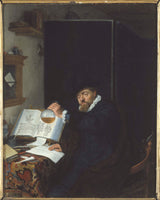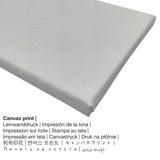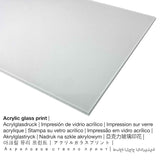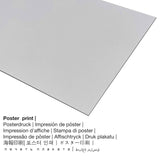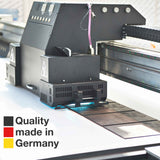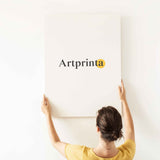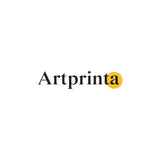Adriaen Van Ostade, 1666 - Nyocha - mbipụta nka mara mma
Ụtụ gụnyere. Mbupu gbakọrọ na ndenye ọpụpụ.
Nkọwapụta edemede
"The Analysis" was by Adriaen Van Ostade in the year 1666. The 350 year old work of art had the size: Height: 28,2 cm, Width: 22,5 cm and was made on the medium Agba mmanụ. Date and signature - Signature and date in the middle left: "A van / Ostade [...] / 1666" was the artpiece's inscription. It can be viewed in in the Petit Palais - Musée des Beaux-arts de la Ville de Paris's collection, which is an art museum in the 8th arrondissement. With courtesy of Petit Palais Paris (ikikere: ngalaba ọha).In addition, the artwork has the creditline: . Moreover, alignment is in Eserese format n'akụkụ akụkụ nke 1: 1.2, nke pụtara na ogologo bụ 20% mkpụmkpụ karịa obosara. Adriaen Van Ostade was a engraver, artist, painter from the Netherlands, whose style can be attributed primarily to Baroque. The painter was born in the year 1610 in Haarlem, North Holland, Netherlands and deceased at the age of 75 in 1685 in Haarlem, North Holland, Netherlands.
Ozi mgbakwunye site na webụsaịtị ihe ngosi nka (© Nwebiisinka - Petit Palais - Musée des Beaux-arts de la Ville de Paris - Petit Palais - Musée des Beaux-arts de la Ville de Paris)
In Dutch painting of the seventeenth century, examining a bottle of urine was used to represent doctors, often satirically, in assimilating to charlatans. The fanciful costume was a marker of distinction between good and evil doctor (Gerard Dou, "The Doctor", Vienna, Kunsthistorisches Museum). Sitting at his desk, the man examines a vial. Dressed in black and wearing a hat, it raises the bottle at eye level, to examine in daylight. In good scientist, he consulted the herbarium open on his desk and prepares to draw conclusions from its analysis on a leaflet blank to comment. It is learned qu'Adriaen Van Ostade represented his medical potential. The concentrated gaze, wisdom permeating his face, he is closer to the iconography of the lawyers in their study that the charlatan. The fineness of the painting and rendering textures, such as the oriental table mat, are characteristic of the evolution of painting from Van Ostade in the 1660s, towards greater artistic maturity. Each element of the composition is rendered with naturalism, giving the portrait of the scientist a psychological dimension.
On June 7, 1708, the table included in a sale in Amsterdam. He entered the collection of Johan Hendrik van Wassenaer Obdam graaf and remained probably until the death of this one in 1745. On 19 August 1750 Bisschop bought for 350 FL when selling the Hague, De Hondt. The analysis obtained for during "A Stove flaking fish" (location unknown) and it is with him that he was again sold, this time in Paris, July 19, 1774, in Collins, for 750 pounds. We do not know what date, the two pendant entered the collection of Abel Poisson Marquis de Menars. The posthumous sale of the latter allowed Claude Tolozan, introducer of ambassadors to the court of the king, to make the acquisition for 611 pounds. Then "The analysis" passed into the collection of Laneuville for 810 francs (sales & Paillet Delaroche, Paris, 23 February 1801) in the collection Séréville in that of Lafontaine for 1,500 francs (Paillet sale Laneuville & Olivier, Paris, January 22, 1812), Casimir Perier and Paul Perier. That's when Bonnefons sales Lavialle in Paris on 16 and 17 March 1843 Augustus Dutuit acquired it at a price of 6001 francs. The table remained in Rouen, in the collection of Dutuit two brothers, Eugene and Augustus, until Augustus bequeathed to the City of Paris in 1902.
Genre scene, Doctor, Man, Hat, Desk, Bottle, Book, Carpet
Nkọwa ahaziri nke ihe nka
| Aha nka: | "The Analysis" |
| Nhazi: | sere |
| Otu sara mbara: | nka ochie |
| Time: | 17th narị afọ |
| Emepụtara n'afọ: | 1666 |
| Afọ nka: | 350 afọ |
| Ihe osise izizi: | Agba mmanụ |
| Nha ihe osise izizi: | Ogologo: 28,2 cm, obosara: 22,5 cm |
| Akanyere (ọrụ nka): | Date and signature - Signature and date in the middle left: "A van / Ostade [...] / 1666" |
| Ụlọ ihe ngosi nka / ebe: | Petit Palais - Musée des Beaux-arts de la Ville de Paris |
| Ebe ngosi nka: | Paris, France |
| website: | Petit Palais - Musée des Beaux-arts de la Ville de Paris |
| Licensedị ikike: | ngalaba ọha |
| Site n'aka: | Petit Palais Paris |
Onye na-ese ihe
| Aha onye nka: | Adriaen Van Ostade |
| Aha nka ndị ọzọ: | A. van Oostaade, אוסטד אדריאן ון, A. V Ostaade, Genre d'Adrien Van Ostade, Ariaen van Ostade, Ostade Adriaen von, Adrian Ostada, Ostade Adrian van, adriaan v. ostade, A. V. Ostaade, A: Ostade, Adriaan v. Oostade, Adriaan van Ostade, Adrien Vanostade, Adr. Van Ostade, A. v Oostaade, Adr. v Oostaade, Ostade Adriaen van, Adriaen von Ostade, Adr. van Ostaade, Van Ostade Adriaen, A. Osatde, van ostade a., Adriaen Jansz van Ostade, Adrianen van Ostade, Adriaen van Ostade, Ostade Adriaan van, A. v Oostade, ostade adrian, Adrian Ostade, Van Ostade Adrian, Ad. Ostade, ostade adriaen, A. v. Oostaade, A.-V. Ostade, Ostade A. van, van ostade adrien, Ostade Adriaen Jansz. van, von alten Ostade, Ostade Adriaen van, Ad. V... Ostade, Adriaen Ostade, a. v. ostade, Adr. van Oostaade, A.V. Ostade, Ad. Van-Ostade, Adriano van Ostade, A. Ostaden, Adriaen Jansz. Van Ostade, Adriaen van Oostade, Adr. v Ostade, Adrien Ostade, A. Van Ostad, Adrien Van-Ostade, Adriaen Jansz Ostade, A. Van-Ostade, Ad. V. Ostade, Adr. J. van Ostade, Ariaen van Oostaden, A Ostade, Ostade A. von, A. von Ostade, Adrien Van-Ostadens, ostade adriaen van, A. van Oostade, Adrian v. Ostade, Adr. v. Ostade, Adrian van Ostade, Adriaan Ostade, A. van Ostade, Adrien v. Ostade, Adriaan Oostade, Adrian Ostade, A. Ostade, A van Ostade, A:v:oostade, Ad. van Oostaade, Adr. Ostade, A. v Ostade, A von Ostade, A. Ostaade, Adriane Van Ostad, Adriaen van Ossade, Ad. Van Ostade, A. v. Oostade, Adrien van Ostade, Adrian von Ostade, A. J. Ostade |
| Gender: | nwoke |
| Nationality: | Dutch |
| Ọrụ onye na-ese ihe: | onye na-ese ihe, onye na-ese ihe, onye na-ese ihe |
| Obodo onye nka: | mba netherland |
| nhazi ọkwa: | nna ukwu ochie |
| Ụdị nke onye na-ese ihe: | Baroque |
| Nwụrụ na afọ nke: | 75 afọ |
| A mụrụ: | 1610 |
| Amụrụ na (ebe): | Haarlem, North Holland, Netherlands |
| Afọ ọnwụ: | 1685 |
| Obodo ọnwụ: | Haarlem, North Holland, Netherlands |
Kedu ụdị akwụkwọ ebipụta nka mara mma m nwere ike iburu?
In the product dropdown lists you can pick the size and material of your choice. You can choose your your favorite size and material among the following options:
- Mbipụta kanvas: The printed canvas, which should not be mistaken with a real canvas painting, is a digital copy printed from a UV direct printing machine. The canvas makes a attractive, positive impression. Canvas prints are relatively low in weight, which implies that it is quite simple to hang the Canvas print without the help of additional wall-mounts. Because of thata canvas print is suited for any type of wall.
- Mbipụta enyo acrylic: A glossy print on acrylic glass, which is sometimes referenced as a UV print on plexiglass, transforms your favorite artwork into lovely décor and offers a distinct alternative option to aluminium or canvas prints. Your favorite work of art is custom-made thanks to state-of-the-art UV direct printing machines. This creates the impression of and rich colors. The major upside of a plexiglass print is that contrasts and also minor details become identifiable with the help of the very subtle gradation.
- Aluminom dibond (ọkpụkpụ ọla): Aluminium Dibond prints are prints on metal with an outstanding effect of depth. For the Direct Aluminium Dibond option, we print your chosen artwork right on the aluminium composite surface. The bright and white sections of the artpiece shimmer with a silky gloss, however without any glare. Colors are bright and luminous, the fine details of the print appear crisp and clear, and the print has a a matte appearance that you can literally feel.
- Akwụkwọ mmado ebipụtara (akwa akwa akwa): Our poster print is a printed flat canvas with a slight finish on the surface. A printed poster is perfectly appropriate for framing the art copy using a customized frame. Please note, that depending on the absolute size of the canvas poster print we add a white margin 2-6cm around the painting, which facilitates the framing with your custom frame.
Nkọwa ngwaahịa
| Ụdị edemede: | mmepụta nka |
| Usoro mmeghari: | dijitalụ mmeputakwa |
| Produzọ mmepụta: | Mbipụta UV ozugbo |
| Ihe ngosi: | German mmepụta |
| Stockdị ngwaahịa: | na mmepụta ihe |
| Eji ngwaahịa a chọrọ: | nka mgbidi, ihe ndozi ụlọ |
| Nhazi nka nka: | nhazi ihe osise |
| Oke akụkụ onyonyo: | ogologo: obosara 1:1.2 |
| Pụtara nke akụkụ akụkụ: | ogologo bụ 20% mkpụmkpụ karịa obosara |
| Ngwa ngwaahịa dị: | mbipụta ọla (aluminium dibond), mbipụta akwụkwọ mmado (akwụkwọ kwaaji), mbipụta kanvas, mbipụta iko acrylic (nwere ezigbo mkpuchi iko) |
| Mbipụta kanvas (akwa akwa na etiti ihe ndọtị): | 50x60cm - 20x24", 100x120cm - 39x47", 150x180cm - 59x71" |
| Mbipụta iko acrylic (nke nwere ezigbo mkpuchi iko): | 50x60cm - 20x24", 100x120cm - 39x47", 150x180cm - 59x71" |
| Mpempe akwụkwọ mmado (akwụkwọ kwaaji) nha dị iche iche: | 50x60cm - 20x24", 100x120cm - 39x47" |
| Nhọrọ nha nha nke Dibond (ihe alumnium): | 50x60cm - 20x24", 100x120cm - 39x47" |
| ụba: | enweghị etiti |
Nkwupụta iwu: We try what we can to depict the products with as many details as it is possible and to exhibit them visually on the respective product detail pages. However, the pigments of the print materials, as well as the printing might vary marginally from the representation on the screen. Depending on your settings of your screen and the condition of the surface, not all color pigments are printed as exactly as the digital version depicted here. Considering that all our art prints are printed and processed manually, there might as well be minor differences in the motif's exact position and the size.
© Copyright - ikike ọgụgụ isi nke | Artprinta.com (Artprinta)

